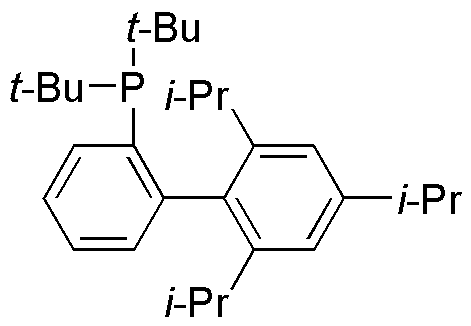tBuXPhos is widely utilized in research focused on:
- Catalysis: This compound serves as a highly effective ligand in various catalytic reactions, particularly in palladium-catalyzed cross-coupling processes. Its steric properties enhance reaction selectivity and yield.
- Organic Synthesis: Researchers leverage tBuXPhos for synthesizing complex organic molecules, benefiting from its ability to stabilize reactive intermediates and improve reaction rates.
- Pharmaceutical Development: In the pharmaceutical industry, it aids in the development of new drugs by facilitating the formation of carbon-carbon bonds, which is crucial for constructing diverse molecular architectures.
- Material Science: The compound is also applied in the development of advanced materials, including polymers and nanomaterials, due to its unique electronic properties and ability to enhance material performance.
- Green Chemistry: tBuXPhos contributes to more sustainable practices by enabling reactions that require milder conditions, thus reducing the environmental impact compared to traditional methods.
General Information
Properties
Safety and Regulations
Applications
tBuXPhos is widely utilized in research focused on:
- Catalysis: This compound serves as a highly effective ligand in various catalytic reactions, particularly in palladium-catalyzed cross-coupling processes. Its steric properties enhance reaction selectivity and yield.
- Organic Synthesis: Researchers leverage tBuXPhos for synthesizing complex organic molecules, benefiting from its ability to stabilize reactive intermediates and improve reaction rates.
- Pharmaceutical Development: In the pharmaceutical industry, it aids in the development of new drugs by facilitating the formation of carbon-carbon bonds, which is crucial for constructing diverse molecular architectures.
- Material Science: The compound is also applied in the development of advanced materials, including polymers and nanomaterials, due to its unique electronic properties and ability to enhance material performance.
- Green Chemistry: tBuXPhos contributes to more sustainable practices by enabling reactions that require milder conditions, thus reducing the environmental impact compared to traditional methods.
Documents
Safety Data Sheets (SDS)
The SDS provides comprehensive safety information on handling, storage, and disposal of the product.
Product Specification (PS)
The PS provides a comprehensive breakdown of the product’s properties, including chemical composition, physical state, purity, and storage requirements. It also details acceptable quality ranges and the product's intended applications.
Certificates of Analysis (COA)
Search for Certificates of Analysis (COA) by entering the products Lot Number. Lot and Batch Numbers can be found on a product’s label following the words ‘Lot’ or ‘Batch’.
Numéro de catalogue
Numéro de lot/série
Certificates Of Origin (COO)
This COO confirms the country where the product was manufactured, and also details the materials and components used in it and whether it is derived from natural, synthetic, or other specific sources. This certificate may be required for customs, trade, and regulatory compliance.
Numéro de catalogue
Numéro de lot/série
Safety Data Sheets (SDS)
The SDS provides comprehensive safety information on handling, storage, and disposal of the product.
DownloadProduct Specification (PS)
The PS provides a comprehensive breakdown of the product’s properties, including chemical composition, physical state, purity, and storage requirements. It also details acceptable quality ranges and the product's intended applications.
DownloadCertificates of Analysis (COA)
Search for Certificates of Analysis (COA) by entering the products Lot Number. Lot and Batch Numbers can be found on a product’s label following the words ‘Lot’ or ‘Batch’.
Numéro de catalogue
Numéro de lot/série
Certificates Of Origin (COO)
This COO confirms the country where the product was manufactured, and also details the materials and components used in it and whether it is derived from natural, synthetic, or other specific sources. This certificate may be required for customs, trade, and regulatory compliance.


